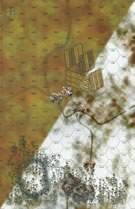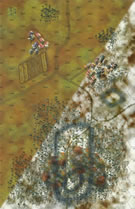|
Cuts Like a Knife Maple Leaf Brigade #4 |
||
|---|---|---|
| (Defender) Canada | vs | Soviet Union (Attacker) |
| Formations Involved | ||
|---|---|---|
| Canada |  |
27th Brigade Group |
| Soviet Union |  |
10th Guards "Uralsko-Lvovskaya" Tank Corps |

|
| Overall Rating, 2 votes |
|---|
|
3.5
|
| Scenario Rank: --- of 964 |
| Parent Game | Maple Leaf Brigade |
|---|---|
| Historicity | Alt-History |
| Date | 1951-10-10 |
| Start Time | 09:00 |
| Turn Count | 30 |
| Visibility | Day |
| Counters | 143 |
| Net Morale | 0 |
| Net Initiative | 1 |
| Maps | 2: 22, 23 |
| Layout Dimensions | 56 x 43 cm 22 x 17 in |
| Play Bounty | 187 |
| AAR Bounty | 167 |
| Total Plays | 2 |
| Total AARs | 1 |
| Battle Types |
|---|
| Road Control |
| Conditions |
|---|
| Off-board Artillery |
| Scenario Requirements & Playability | |
|---|---|
| Elsenborn Ridge | Maps |
| Hammer & Sickle | Counters |
| Maple Leaf Brigade | Base Game |
| Road to Berlin | Counters |
| Introduction |
|---|
|
The Canadian unit’s “fire brigade” role meant that it would be flung into the breach wherever needed on the central front. It would be very likely, therefore, to have to face the Soviet Army’s best divisions. On the British Army of the Rhine’s sector that would be the Third Shock Army’s 10th Guards Tank Division, a Red Banner unit with a proud history as a unique workers’ volunteer tank corps during the Great Patriotic War. In facing the 10th Guards they would have to blunt the sharp end of Third Shock Army's spearhead. |
| Conclusion |
|---|
|
Armor support would help the Canadian defense, but even the mighty Centurion would be outmatched by the Josef Stalin III. The Canadians would have to count on their superior morale and leadership to overcome the Soviet edge in tanks, but that calculation was the basis of the NATO alliance’s strategic thinking for the entire Cold War. As October ground on, the Soviets needed to penetrate the screening efforts of the Canadians to try to move towards the rear assembly areas where additional NATO forces would be constituted. It was clear that the BAOR was beginning to move from defense to offense and a breakthrough would delay that transition. |
| AFV Rules Pertaining to this Scenario's Order of Battle |
|---|
|
| 1 Errata Item | |
|---|---|

|
Kommissars never get morale or combat modifiers. Ignore misprints. (Shad
on 2010 Dec 15)
|
| Canada takes some hits |
|---|
|
This was a bloody brawl that was resolved in relatively few turns. The Soviet guards have roughly 3 battalions of mechanized infantry and tank-riding SMGs, plus about a battalion of T44 tanks supported by some JS3 platoons. Their task is to pick one of the two main east west roads and control all the hexes by the end of 7.5 hours. The Canadians have two battalions of mech infantry, a company of tanks, and numerous AT guns to stop them with. The Soviet plan was to attack in strength along the northern road, including a deep penetration by tanks and SMGs to try to unhinge the Canadian defense of a forward town. The Soviet plan appeared to be working, as Canadian forces were losing their grip on the town and taking casualties like they had never experienced in the earlier battles. But a Canadian mechanized counterattack swept around the Soviet force and hit their flank, and Canadian tanks began to finish off the Soviet tanks. Ultimately the Soviets sustained heavy losses but held the eastern town in strength, the Canadians retreated to form a new defensive line protecting the western end of the road. As the Soviets lacked the strength to continue the attack against a solid defense, they accepted defeat with half the road under their control. I imagine in reality this would be seen as a marginal Canadian defeat. They lost a lot of infantry and a few tanks, gave up half the territory they needed to hold, and would be sorely pressed by any follow-on attack. And the Soviets always have more mechanized regiments to throw into battle. |
| 0 Comments |

 MaLB003
MaLB003 





























